-

新人教版高中英语选修4Unit 2 Iconic Attractions教案
帮助学生通过讨论与对主题的提升,反思自己的旅游方式,以便做出更优化的安排,在今后的旅程中有更多的收益。 Activity 2: Further discussion of the 6 elements above and supplement of more background knowledge 本活动为实现课时教学目标2。 1.Target Q: The writer’s clear target of traveling, meeting the people and experiencing the culture, is closely related to his major in social studies. Then what is social studies? Social studies is a part of a school or college curriculum concerned with the study of social relationships and the functioning of society and usually made up of courses in history, government, economics, civics, sociology, geography, and anthropology. (Dictionary by Merriam-Webster) Reflection: When you go out to travel, what targets do you usually have in mind? 2.Research Q: Suppose you are traveling to Hangzhou during the school holidays, how will you do research on the city? (surf the internet, read books or travel brochures, consult friends, ...) What information will you be interested to know? (location, iconic sites, local cuisines, interesting customs, shopping malls ...) 3.Abandonment To make the most of time, we have to learn to abandon so that we can accomplish our plan. What will you be interested in doing if you go to Hangzhou if you have a week’s time? What if you only have 2 days? 4~5. Venturing & Experiencing Q: What did he venture to do during the trip? What new experiences did he have? In Sydney: attend his first open-air barbecue, enjoy many different but yummy meals In Catherine: observe the life and customs of the aborigines appreciate their music & try the musical instruments: the didgeridoo
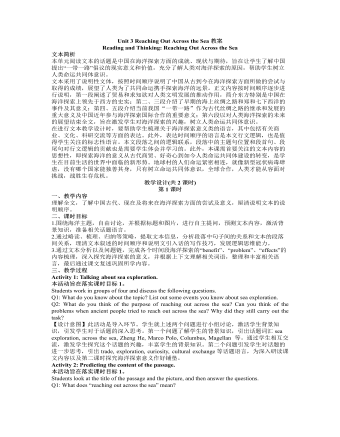
新人教版高中英语选修4Unit 3 Reaching Out Across the Sea教案
本活动旨在落实课时目标3。 Think about the following questions and talk about your own attitude in pairs.Q1: As for this topic,what impresses you the most in the passage?Q2: What do you think of the future of China’s further exploration in sea? Are you in favor of the further exploration?Why or why not? 【设计意图】该活动是一个完全开放性的活动,每个学生都会有不同的答案。运用迁移所学,自由口头表达自己对海洋探索的态度。对于中国海洋探索的未来,每个人的想法是不一样的,有乐观,有担忧,有认为值得投入,也有认为不值得付出太大代价,这里给学生自由表达的空间只要学会有支撑自己观点的事实就可以了,进一步培养学生批判性思维和正确的价值观。 Assignment: 此任务旨在迁移一、二课时所学,培养学生辩证分析问题的能力。 Write about your idea of the future of China’s sea exploration. And add your attitude towards the effort China have made in sea exploration. You’re expected to use the language and the writing technique learnt in the passage.

新人教版高中英语选修4Unit 4 Sharing教案
【核心素养提升点】学会将抽象信息进行可视化表达,提高信息处理能力和分析、推理等高阶思维品质;在跨文化交际中学会以国际视野接受和包容不同的文化。 5.Read Paragraph 2, draw a mind map and answer the questions. Q1:What did Jo learn about Tombe’s life? Q2:What kind of life do the natives lead? Read paragraph 2-5 and draw a mind-map. (Focus on accommodation, possession, diet and belief) 【设计意图】引导学生利用思维导图和问题链等形式来厘清当地人的生活方式,更好地处理和归纳信息 【核心素养提升点】提高信息处理能力、分析和归纳能力,包容异国文化、扩展国际视野。 6.Read Paragraph 3 and answer the questions. Q1:What was Jo’s feeling upon arriving her own home? Q2:Why would she feel that way? Q3:Do you think “It was such a privilege to have spent a day with Tombe’s family”? 【设计意图】通过提问,让学生理解Jo的苦并快乐的心情,并通过对“It was such a privilege to have spent a day with Tombe’s family”这句话的理解,体验志愿者生活的伟大。 【核心素养提升点】学会对信息的综合和归纳,从而理解作者所表达的观点。 Activity4: Summarize the change of Jo's feelings

新人教版高中英语选修4Unit 5 Language Your Career教案
本单元阅读文本向中学生推荐职业能力测试(Career Aptitude Test),旨在建议学生利用职业倾向测试来发现自己更感兴趣、更有潜力的学习或职业方向,并规划自己的未来职业。 本文采用了建议性文本,全篇从职业生涯的重要意义讲起,针对中学生对职业规划比较迷茫的现状,提出了职业倾向测试这一建议。全文共七段,其中第一段和第二段为第一部分,其余五段为第二部分。第一部分论述职业的重要性和职业生涯规划的最佳时间是在校期间,第二部分提出解决职业选择困惑可以通过完成职业能力测试,介绍了不同种类的职业倾向测试,结合图表详细说明其中一种操作步骤,并提醒职业建议也基于学历和经验,最后一段概括论述,建议学生通过职业能力测试这一有效的工具,找到自己真正热爱的事物。 在文本教学设计时,要帮助学生梳理有关职业的话题语言。阅读策略层面,指导学生通过学习图表和图形,在有限的空间内获取广泛信息,如阅读图表标题,图表上的标签,X轴Y轴上的数据所指。

中班语言教案:趣味识动字—跳、爬、吹、打
2、激发幼儿学习兴趣,积极参与游戏活动。准备:多媒体课件(跳、爬、吹、打四个字);骰子一个;打、吹的物品;会爬动物的头饰(如虫、蜗牛);圈; 过程:一:看动画识字上次我们去动物园,看到了很多动物,还看到了海狮和大象为我们表演的节目,小朋友,觉得怎么样啊?有些小动物今天来到幼儿园,还要为我们表演节目,我们来看看它们是谁。 A:(1)图上是谁?它在干什么?我们来学学小公鸡吹喇叭吧!(2)小公鸡还带来一个字宝宝,认识一下吧,这是“吹”宝宝,请“吹”宝宝也表演一个节目。(3)还有什么东西也可以吹呢?是用什么吹的?“吹”宝宝的身上有什么?
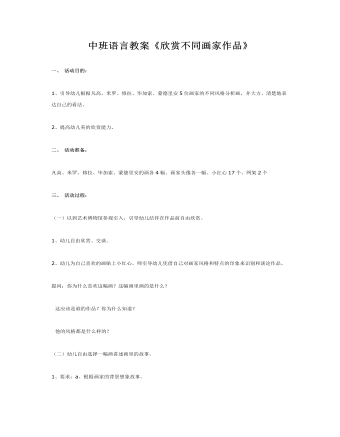
中班语言教案《欣赏不同画家作品》
2、提高幼儿美的欣赏能力。二、活动准备:凡高、米罗、修拉、毕加索、蒙德里安的画各4幅、画家头像各一幅、小红心17个、网架2个三、活动过程:(一)以到艺术博物馆参观引入,引导幼儿结伴在作品前自由欣赏。1、幼儿自由欣赏、交谈。2、幼儿为自己喜欢的画贴上小红心。师引导幼儿凭借自己对画家风格和特点的印象来
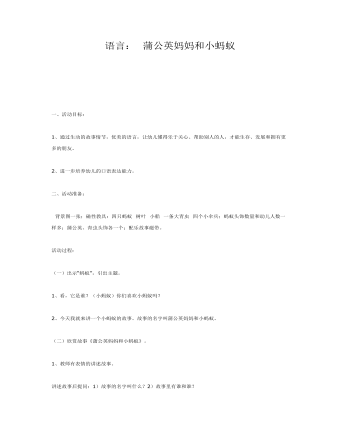
中班语言课件教案: 蒲公英妈妈和小蚂蚁
2、进一步培养幼儿的口语表达能力。二、活动准备: 背景图一张;磁性教具:四只蚂蚁 树叶 小船 一条大青虫 四个小伞兵;蚂蚁头饰数量和幼儿人数一样多;蒲公英、青虫头饰各一个;配乐故事磁带。活动过程:(一)出示“蚂蚁”,引出主题。1、看,它是谁?(小蚂蚁)你们喜欢小蚂蚁吗?2、今天我就来讲一个小蚂蚁的故事。故事的名字叫蒲公英妈妈和小蚂蚁。(二)欣赏故事《蒲公英妈妈和小蚂蚁》。1、教师有表情的讲述故事。讲述故事后提问:1)故事的名字叫什么?2)故事里有谁和谁?2、出示背景图,教师边演示教具边讲故事。讲述过程中提问:1)小河的对岸住着谁?2)一阵大风吹来,小蚂蚁坐的树叶小船怎么了?3)野地里有什么?它是什么样子的?4)蒲公英是怎样对待小蚂蚁的?5)小蚂蚁说了些什么?蒲公英妈妈又说了些什么?6)蒲公英妈妈为什么很感激小蚂蚁?7)小蚂蚁是怎样回到自己家的?8)这个故事告诉了我们一个什么道理?
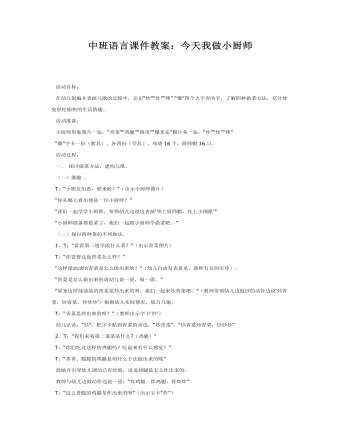
中班语言课件教案:今天我做小厨师
活动准备: 小厨师形象图片一张,“青菜”“鸡腿”“肉串”“爆米花”图片各一张,“炒”“炸”“烤” “爆”字卡一份(教具)、各四份(学具),布袋16个,厨师帽16只。 活动过程: 一、探讨做菜方法,建构儿歌。 (一)激趣。 T:“小朋友们看,谁来啦?”(出示小厨师图片) “你从哪儿看出他是一位小厨师?” “我们一起学学小厨师,带领幼儿边说边表演‘带上厨师帽,挂上小围裙’” “小厨师准备要做菜了,我们一起跟小厨师学做菜吧。” (二)探讨四种菜的不同做法。 1、T:“看看第一道学做什么菜?”(出示青菜图片) T:“你觉得这盘青菜怎么样?” “这样绿油油的青菜是怎么做出来的?”(幼儿自由发表意见,教师有目的引导)。 “青菜是怎么做出来的请幼儿说一说,做一做。” “原来这样绿油油的青菜是炒出来的呀,我们一起来炒青菜吧。”(教师带领幼儿边做炒的动作边说‘炒青菜,炒青菜,炒炒炒’)根据幼儿实际情况,练习几遍。 T:“青菜是炒出来的呀?”(教师出示字卡‘炒’) 幼儿认读:“炒”,把字卡贴到青菜的旁边,“炒青菜”、“炒青菜炒青菜,炒炒炒” 2、T:“我们来看第二道菜是什么?(鸡腿)” T:“你们吃过这样的鸡腿吗?吃起来有什么感觉?”

中班语言课件教案:兔子先生去散步
第一环节,我以兔子的家为导入,看看猜猜,“这是谁的家啊?”让孩子在细致地观察中发现,培养阅读观察的能力。第二环节,是活动的重点,用看图猜谜的活动形式层层引入,根据故事中的标志联想故事的情节。当然在过程中谜底不是绝对的,例如眼泪的那段,也可以是雨滴、水滴、油滴,以引发孩子的讨论。在整个欣赏的过程中注重故事的完整性,在分段欣赏时,从故事开始到“小心坑洞”的那段,内容基本不变,后面的一段留一个疑问,“兔子先生掉到洞里后会碰到什么呢?”引起孩子完整欣赏故事的兴趣,在完整欣赏时了解答案。 第三环节,注重将文学作品回归到孩子的生活中。引导孩子交流讨论生活周围的图象与符号,自然引入社会认知的活动,活动有可持续发展的价值,如延伸活动“寻找生活中的标志、幼儿园、马路上的标志等等。
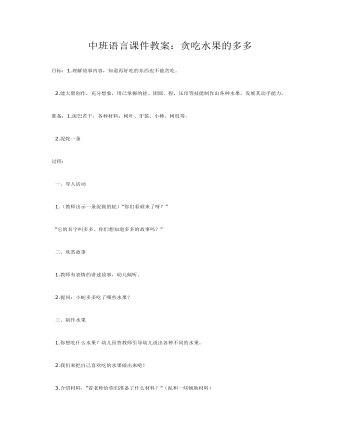
中班语言课件教案:贪吃水果的多多
2.能大胆创作,充分想象,用已掌握的搓、团圆、捏、压印等技能制作出各种水果,发展其动手能力。准备:1.泥巴若干,各种材料:树叶、牙签、小棒,树枝等。 2.泥蛇一条过程: 一、导入活动 1.(教师出示一条泥做的蛇)“你们看谁来了呀?” “它的名字叫多多。你们想知道多多的故事吗?” 二、欣赏故事 1.教师有表情的讲述故事,幼儿倾听。 2.提问:小蛇多多吃了哪些水果?
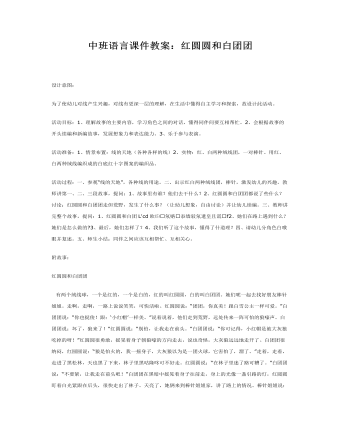
中班语言课件教案:红圆圆和白团团
活动准备:1、情景布置:线的天地(各种各样的线)2、实物:红、白两种绒线团,一对棒针。用红、白两种绒线编织成的白底红十字图案的编织品。活动过程:一、参观“线的天地”,各种线的用途。二、出示红白两种绒线团,棒针,激发幼儿的兴趣。教师讲第一、二、三段故事,提问:1、故事里有谁?他们去干什么?2、红圆圆和白团团都说了些什么?讨论:红圆圆和白团团走但荒野,发生了什么事?(让幼儿想象,自由讨论)并让幼儿续编。三、教师讲完整个故事,提问:1、红圆圆和白团L'cd欧⑸氖赂忝墙驳氖遣皇且谎f2、她们在路上遇到什么?她们是怎么做的?3、最后,她们怎样了?4、我们听了这个故事,懂得了什道理?四、请幼儿分角色白哦眼并复述。五、师生小结:同伴之间应该互相帮忙、互相关心。
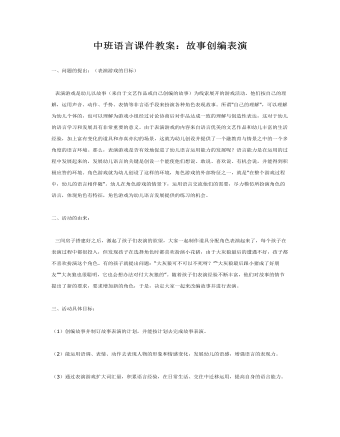
中班语言课件教案:故事创编表演
二、活动的由来: 三间房子搭建好之后,激起了孩子们表演的欲望,大家一起制作道具分配角色表演起来了,每个孩子在表演过程中都很投入,但发现孩子在选择角色时都喜欢扮演小花猪,由于大灰狼最后的遭遇不好,孩子都不喜欢扮演这个角色。有的孩子就提出问题:“大灰狼可不可以不死呀?”“大灰狼最后跟小猪成了好朋友”“大灰狼也很聪明,它也会想办法对付大灰狼的”。随着孩子们表演经验不断丰富,他们对故事的情节提出了新的要求,要求增加新的角色,于是,决定大家一起来改编故事并进行表演。三、活动具体目标:(1)创编故事并制订故事表演的计划,并能按计划去完成故事表演。(2)能运用语调、表情、动作去表现人物的形象和情感变化,发展幼儿的语感,增强语言的表现力。(3)通过表演游戏扩大词汇量,积累语言经验,在日常生活、交往中迁移运用,提高自身的语言能力。(4)培养幼儿自信、勇敢、大方的个性,能积极主动与人交谈、协商、合作与交往。
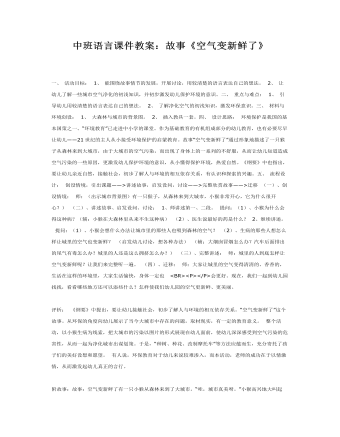
中班语言课件教案:故事《空气变新鲜了》
1、大森林与城市的背景图。 2、插入教具一套。四、设计思路: 环境保护是我国的基本国策之一。“环境教育”已走进中小学的课堂。作为基础教育的有机组成部分的幼儿教育,也有必要尽早让幼儿——21世纪的主人从小接受环境保护的启蒙教育。故事“空气变新鲜了”通过形象地描述了一只猴子从森林来到大城市,由于大城市的空气污染,而出现了身体上的一系列的不舒服,从而让幼儿知道造成空气污染的一些原因,更激发幼儿保护环境的意识,从小懂得保护环境,热爱自然。《纲要》中也指出,要让幼儿亲近自然,接触社会,初步了解人与环境的相互依存关系,有认识和探索的兴趣。五、流程设计: 创设情境,引出课题——>讲述故事,启发设问,讨论——>完整欣赏故事——>迁移 (一)、创设情境: 师:(出示城市背景图)有一只猴子,从森林来到大城市,小猴非常开心,它为什么很开心?) (二)、讲述故事、启发设问、讨论: 1、师讲述第一、二段。 提问:(1)、小猴为什么会得这种病?(辅:小猴在大森林里从来不生这种病) (2)、医生说最好的药是什么? 2、继续讲述。 提问:(1)、小猴会想什么办法让城市里的那些人也吸到森林的空气? (2)、生病的那些人想怎么样让城里的空气也变新鲜? (启发幼儿讨论,想各种办法) (辅:大烟囱冒烟怎么办?汽车后面排出的尾气有毒怎么办?城里的人还是这么拥挤怎么办?) (三)、完整讲述: 师:城里的人到底怎样让空气变新鲜呢?让我们来完整听一遍。 (四)、迁移: 师:大家让城里的空气变得清清的、香香的,生活在这样的环境里,大家生活愉快,身体一定也 会更好。现在,我们一起到幼儿园找找,看看哪些地方还可以添些什么?怎样使我们幼儿园的空气更新鲜、更美丽。
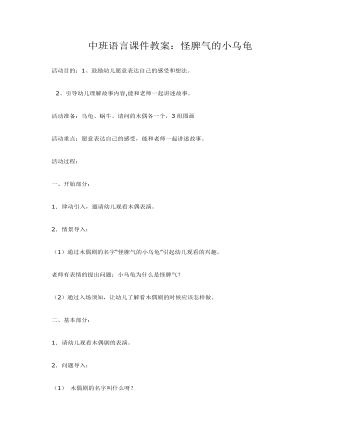
中班语言课件教案:怪脾气的小乌龟
2、引导幼儿理解故事内容,能和老师一起讲述故事。活动准备:乌龟、蜗牛、请问的木偶各一个,3组图画活动重点:愿意表达自己的感受,能和老师一起讲述故事。活动过程:一、开始部分:1. 律动引入,邀请幼儿观看木偶表演。2. 情景导入:(1)通过木偶剧的名字“怪脾气的小乌龟”引起幼儿观看的兴趣。老师有表情的提出问题:小乌龟为什么是怪脾气?(2)通过入场须知,让幼儿了解看木偶剧的时候应该怎样做。
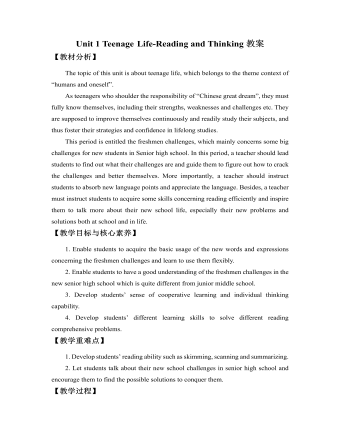
新人教版高中英语必修1Unit 1 Teenage Life-Reading and Thinking教案
【教材分析】The topic of this unit is about teenage life, which belongs to the theme context of “humans and oneself”.As teenagers who shoulder the responsibility of “Chinese great dream”, they must fully know themselves, including their strengths, weaknesses and challenges etc. They are supposed to improve themselves continuously and readily study their subjects, and thus foster their strategies and confidence in lifelong studies.This period is entitled the freshmen challenges, which mainly concerns some big challenges for new students in Senior high school. In this period, a teacher should lead students to find out what their challenges are and guide them to figure out how to crack the challenges and better themselves. More importantly, a teacher should instruct students to absorb new language points and appreciate the language. Besides, a teacher must instruct students to acquire some skills concerning reading efficiently and inspire them to talk more about their new school life, especially their new problems and solutions both at school and in life.【教学目标与核心素养】1. Enable students to acquire the basic usage of the new words and expressions concerning the freshmen challenges and learn to use them flexibly.2. Enable students to have a good understanding of the freshmen challenges in the new senior high school which is quite different from junior middle school.3. Develop students’ sense of cooperative learning and individual thinking capability. 4. Develop students’ different learning skills to solve different reading comprehensive problems.

新人教版高中英语必修1Unit 2 Travelling Around-Reading and Thinking教案
Good expressions that students can choose to use: help the travelers choose which tour to take1. In my opinion, you could/might choose…, because you prefer to…2. …could be a perfect choice for you, for…3. As far as I am concerned, you would enjoy…, for…4. …would probably suit you, because you enjoy/love/hate doing…Step 5 Passage ConsolidationLanguage appreciation:1. You can then spend three days exploring the rainforest with a local guide and enjoying the plants and animals unique to the rainforest. 在接下来的三天里,您可以在当地导游的陪同下,深入雨林进行探索,欣赏雨林特有的动植物。本句主体结构为spend some time doing sth. 2. Inca builders cut stones to exact sizes so that nothing was needed to hold walls together other than the perfect fit of the stones. 印加的建筑工人将石头切割成精确的尺寸,仅仅凭着石头间的完美契合,即可稳固墙体。本句为so that引导的结果状语从句。nothing与the perfect fit为并列成分; other than在句中意为“除了”。Step 6 HomeworkSuppose you will travel to Peru, write a short essay about your three-day tour plan.
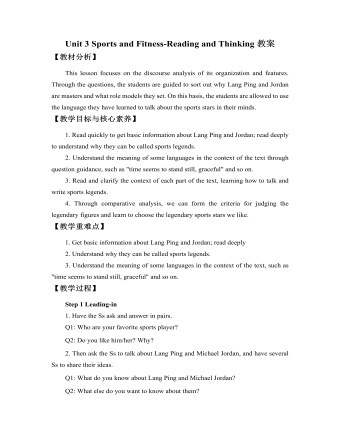
新人教版高中英语必修1Unit 3 Sports and Fitness-Reading and Thinking教案
2. Sort out detailed information about Michael Jordan.(1) Understand the transitional sentence.Q: Which part is about Michael Jordan as a master? Which part is about the example he set?(2) Have the Ss Focus on why Michael Jordan is a master and what good examples Michael Jordan set when they’re reading. And think about these questions as below:Q1: How does the author describe his impressive skills?Q2: How do you understand “time seemed to stand still”?Q3: What does “graceful” mean?Q4. Which sentence do you think best describes his mental strength?Q5. Which words is important in the sentence in describing his mental strength? Why?Q6: How do you understand “unique”?Q7: What can we learn from Michael Jordan?Step 5 Discussing and recommendingRecommend their own living legends of sports.Work in groups to choose your own living legend of sports and give the reasons of your choice. Step 6 HomeworkReview the stories of Lang Ping and Michael Jordan, and try to retell them.
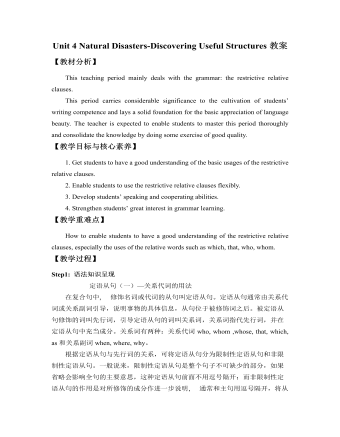
新人教版高中英语必修1Unit 4 Natural Disasters-Discovering Useful Structures教案
【教材分析】This teaching period mainly deals with the grammar: the restrictive relative clauses.This period carries considerable significance to the cultivation of students’ writing competence and lays a solid foundation for the basic appreciation of language beauty. The teacher is expected to enable students to master this period thoroughly and consolidate the knowledge by doing some exercise of good quality.【教学目标与核心素养】1. Get students to have a good understanding of the basic usages of the restrictive relative clauses.2. Enable students to use the restrictive relative clauses flexibly.3. Develop students’ speaking and cooperating abilities.4. Strengthen students’ great interest in grammar learning.【教学重难点】How to enable students to have a good understanding of the restrictive relative clauses, especially the uses of the relative words such as which, that, who, whom.【教学过程】Step1: 语法知识呈现定语从句(一)—关系代词的用法在复合句中, 修饰名词或代词的从句叫定语从句。定语从句通常由关系代词或关系副词引导,说明事物的具体信息,从句位于被修饰词之后。被定语从句修饰的词叫先行词,引导定语从句的词叫关系词,关系词指代先行词,并在定语从句中充当成分。关系词有两种:关系代词who, whom ,whose, that, which, as和关系副词when, where, why。

新人教版高中英语必修1Unit 4 Natural Disasters-Reading & Thinking教案
5. Read to get detailed information about Paragraph 5.Q1. What shows the revival of Tangshan?Q2. How can Tangshan revive itself and get up on its feet again?Q3. In times of disasters, how can we go through it?T: In times of disasters, we should unify, show the wisdom and stay positive.Step 4 Activity 4 Highlighting the theme and reflecting1. Make a summary of the text.2. Further understand the titleQ: After our learning, why do you think the earth didn’t sleep on that night?T: An earthquake happened. The people in the earthquake suffered a lot, and the people outside Tangshan were concerned about the people there a lot.3. Reflect through discussion on what can be learnt after reading.T: Disasters are powerful. Unpreparedness can be deadly. Life is weak, but if people work together to help each other, disasters can be defeated.There is no love from disaster, but we have love in the human heart.Step 5 Assignment How does the writer convey that the earthquake was deadly, and that people were helpless during the earthquake? Try to find some attractive and impressive expressions and note them down.

新人教版高中英语必修1Unit 5 Languages Around the World-Reading for Writing教案
Step 3: Read to sum upRead it again and sum up the problems of the three students, and then write down the advice that was given from others.Step 4: Work in pairs. List your learning problems in English and brainstorm some useful advice.Useful expressions ? I don't know how to…... Is a big difficulty for me. I cannot ...? You might try …. It's very important to…? I have no idea how/what .My biggest problem is .... ? I (also) have trouble with. My advice is …. This worked for me.? l cannot understand the teachers’ English in class.Step 5 Homework:为提高我校学生的英语口语水平,我们将举办英语演讲比赛(English- speaking contest),请你根据下面的信息,以学生会(the Students‘ Union)的名义写一份海报,欢迎全校同学参加,届时特邀本校美籍教师史密斯先生颁奖。? 报名时间 9月30日以前(报名:signup)? 报名地点 学生会办公室? 比赛时间 10月9日晚7:00~9:00? 比赛地点 学校大会议室? 奖励 前8名